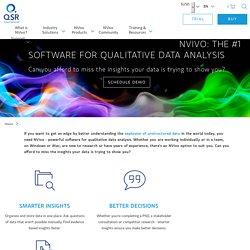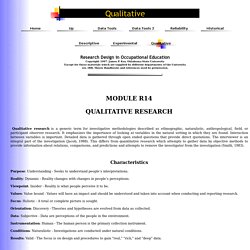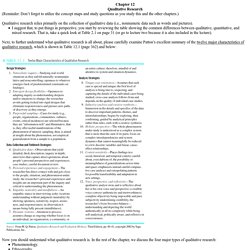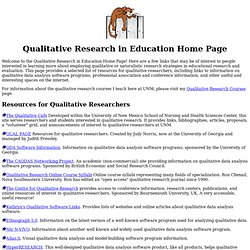

NVivo 8 research software for analysis and insight. Import and analyze documents, images, PDFs, audio, video, spreadsheets, web pages, and Twitter and Facebook data.

5051IR_Prof_dvlpmt_analysis.pdf (application/pdf Object) McREL: Mid-continent Research for Education and Learning. Education Sector: Independent Analysis, Innovative Ideas. The National Center for Fair & Open Testing. Module 6: Qualitative Data Analysis: International Development Research Centre. How and what to code. Authors of this page: Graham R.

Gibbs and Celia Taylor Affiliation: University of Huddersfield Date written: 30th June 2005 Updated 19th Feb 2010 Ref: Taylor, C and Gibbs, G R (2010) "How and what to code", Online QDA Web Site, [onlineqda.hud.ac.uk/Intro_QDA/how_what_to_code.php] Coding. How to use NVivo. About NVivo[edit] NVivo is a proprietary desktop software package for the organization and analysis of complex non numerical unstructured data, also known as qualitative data.

Inferential Statistics. « PreviousHomeNext » With inferential statistics, you are trying to reach conclusions that extend beyond the immediate data alone.

For instance, we use inferential statistics to try to infer from the sample data what the population might think. Or, we use inferential statistics to make judgments of the probability that an observed difference between groups is a dependable one or one that might have happened by chance in this study. Thus, we use inferential statistics to make inferences from our data to more general conditions; we use descriptive statistics simply to describe what's going on in our data. Here, I concentrate on inferential statistics that are useful in experimental and quasi-experimental research design or in program outcome evaluation. Most of the major inferential statistics come from a general family of statistical models known as the General Linear Model. One of the keys to understanding how groups are compared is embodied in the notion of the "dummy" variable. Answers to exercises in Zen - Statistics.
Chapter 12 will not be covered this semester There is no presentation for Chapters 12 week-by-week *Please check the "week-by-week" every week for updates, especially if you don't attend the lectures or read CMNS 260 emails.

Data Analysis/Warehouse Services. Author Tony Vincent speaks at the Digital Wave conference about handheld devices.

The WNYRIC Finance team spent approximately 265 hours from September 1 guiding 96 school districts to the finish line by the October 18 deadline for the second annual APPR data collection. Data Security Symposium held this summer with presenter Mike Tassey of the U.S. Dept. of Privacy Technical Assistance Center (PTAC) who assisted in delivering one of the keynote addresses. Need help? Call our friendly service desk staff. The Literature Review: A Few Tips On Conducting It. The Case Study as a Research Method. Uses and Users of Information -- LIS 391D.1 -- Spring 1997 Introduction Case study research excels at bringing us to an understanding of a complex issue or object and can extend experience or add strength to what is already known through previous research.

Case studies emphasize detailed contextual analysis of a limited number of events or conditions and their relationships. Researchers have used the case study research method for many years across a variety of disciplines. Qualitative. Qualitative research is a generic term for investigative methodologies described as ethnographic, naturalistic, anthropological, field, or participant observer research.

It emphasizes the importance of looking at variables in the natural setting in which they are found. Interaction between variables is important. Detailed data is gathered through open ended questions that provide direct quotations. The interviewer is an integral part of the investigation (Jacob, 1988). This differs from quantitative research which attempts to gather data by objective methods to provide information about relations, comparisons, and predictions and attempts to remove the investigator from the investigation (Smith, 1983). Chapter 12. Chapter 12 Qualitative Research (Reminder: Don’t forget to utilize the concept maps and study questions as you study this and the other chapters.)

Qualitative research relies primarily on the collection of qualitative data (i.e., nonnumeric data such as words and pictures). I suggest that, to put things in perspective, you start by reviewing the table showing the common differences between qualitative, quantitative, and mixed research. That is, take a quick look at Table 2.1 on page 31 (or go to lecture two because it is also included in the lecture). Qualitative Research Methods. Jan Armstrong's Qualitative Research in Education Home Page. Welcome to the Qualitative Research in Education Home Page!

Here are a few links that may be of interest to people interested in learning more about employing qualitative or naturalistic research strategies in educational research and evaluation. This page provides a selected list of resources for qualitative researchers, including links to information on qualitative data analysis software programs, professional association and conference information, and other useful and interesting spaces on the internet. International Education Journal. Syracuse University Library. Teachers For A New Era. Center for the Study of Teaching and Policy: Home Page. Welcome! The Center for the Study of Teaching and Policy investigates efforts to improve the quality of teaching and learning, the teacher workforce, and the systems of support for teachers’ work, in various contexts and at multiple levels of the K-12 educational system.
To that end, Center researchers identify ways that policy actions, leadership, and reform efforts guide, direct, and support teaching and learning, thereby informing and enhancing the quality of learning opportunities in U.S. elementary and secondary schools. Research highlights Recent Center Reports The Center has recently released a synthesis report, Learning-focused Leadership and Leadership Support: Meaning and Practice in Urban Systems.